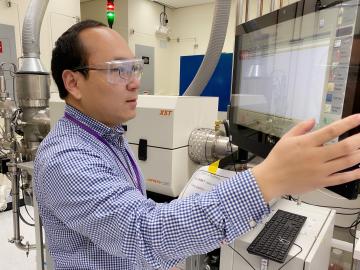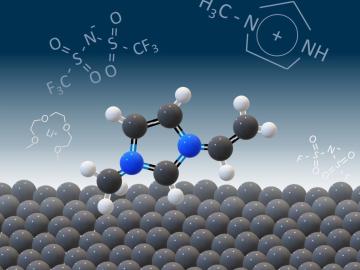
Filter News
Area of Research
- (-) Materials (45)
- (-) National Security (18)
- (-) Nuclear Science and Technology (8)
- (-) Supercomputing (32)
- Advanced Manufacturing (5)
- Biology and Environment (18)
- Computer Science (1)
- Electricity and Smart Grid (2)
- Energy Science (64)
- Functional Materials for Energy (1)
- Fusion and Fission (8)
- Isotopes (2)
- Materials Characterization (1)
- Materials for Computing (8)
- Materials Under Extremes (1)
- Neutron Science (16)
News Type
News Topics
- (-) 3-D Printing/Advanced Manufacturing (14)
- (-) Advanced Reactors (8)
- (-) Big Data (19)
- (-) Composites (3)
- (-) Cybersecurity (12)
- (-) Grid (7)
- (-) Materials Science (38)
- Artificial Intelligence (30)
- Bioenergy (11)
- Biology (12)
- Biomedical (9)
- Biotechnology (2)
- Buildings (4)
- Chemical Sciences (14)
- Clean Water (2)
- Computer Science (60)
- Coronavirus (9)
- Critical Materials (1)
- Energy Storage (17)
- Environment (27)
- Exascale Computing (18)
- Frontier (20)
- Fusion (13)
- High-Performance Computing (34)
- Irradiation (1)
- Isotopes (10)
- ITER (1)
- Machine Learning (16)
- Materials (47)
- Mathematics (2)
- Microscopy (16)
- Molten Salt (2)
- Nanotechnology (21)
- National Security (29)
- Neutron Science (21)
- Nuclear Energy (33)
- Partnerships (6)
- Physics (21)
- Polymers (7)
- Quantum Computing (13)
- Quantum Science (14)
- Security (9)
- Simulation (14)
- Software (1)
- Space Exploration (4)
- Summit (23)
- Transportation (9)
Media Contacts

Two scientists with the Department of Energy’s Oak Ridge National Laboratory have been elected fellows of the American Physical Society.

About 60 years ago, scientists discovered that a certain rare earth metal-hydrogen mixture, yttrium, could be the ideal moderator to go inside small, gas-cooled nuclear reactors.

Two staff members at the Department of Energy’s Oak Ridge National Laboratory have received prestigious HENAAC and Luminary Awards from Great Minds in STEM, a nonprofit organization that focuses on promoting STEM careers in underserved

It’s a new type of nuclear reactor core. And the materials that will make it up are novel — products of Oak Ridge National Laboratory’s advanced materials and manufacturing technologies.

As CASL ends and transitions to VERA Users Group, ORNL looks at the history of the program and its impact on the nuclear industry.

Scientists seeking ways to improve a battery’s ability to hold a charge longer, using advanced materials that are safe, stable and efficient, have determined that the materials themselves are only part of the solution.

ORNL researchers have developed an intelligent power electronic inverter platform that can connect locally sited energy resources such as solar panels, energy storage and electric vehicles and smoothly interact with the utility power grid.

From materials science and earth system modeling to quantum information science and cybersecurity, experts in many fields run simulations and conduct experiments to collect the abundance of data necessary for scientific progress.

In the search to create materials that can withstand extreme radiation, Yanwen Zhang, a researcher at the Department of Energy’s Oak Ridge National Laboratory, says that materials scientists must think outside the box.

The Department of Energy’s Office of Science has selected three Oak Ridge National Laboratory scientists for Early Career Research Program awards.


